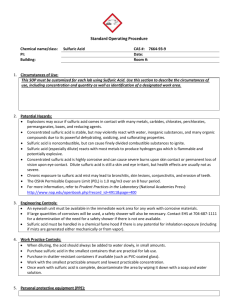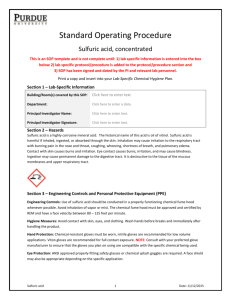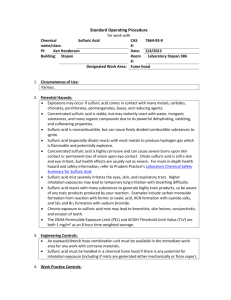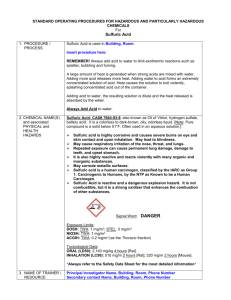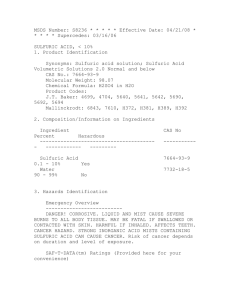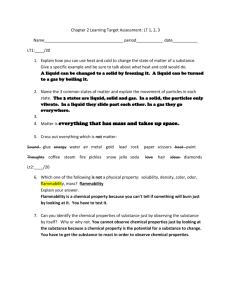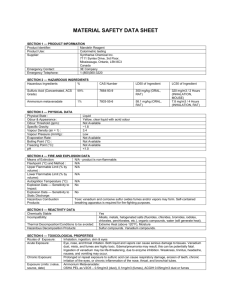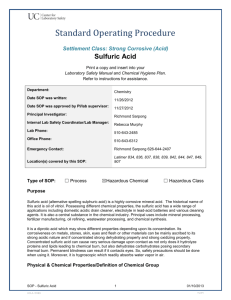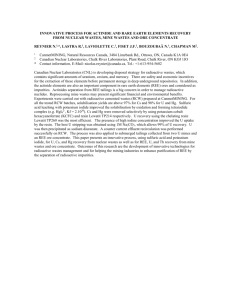Sulfuric Acid - OSEH - University of Michigan
advertisement
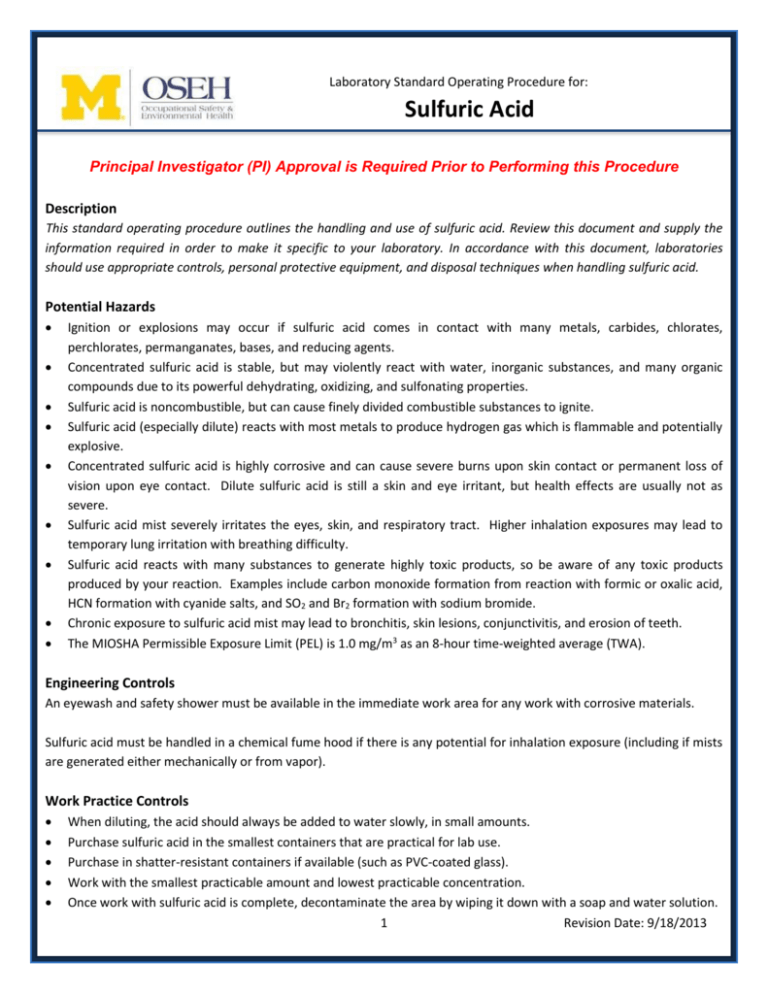
Laboratory Standard Operating Procedure for: Sulfuric Acid Principal Investigator (PI) Approval is Required Prior to Performing this Procedure Description This standard operating procedure outlines the handling and use of sulfuric acid. Review this document and supply the information required in order to make it specific to your laboratory. In accordance with this document, laboratories should use appropriate controls, personal protective equipment, and disposal techniques when handling sulfuric acid. Potential Hazards Ignition or explosions may occur if sulfuric acid comes in contact with many metals, carbides, chlorates, perchlorates, permanganates, bases, and reducing agents. Concentrated sulfuric acid is stable, but may violently react with water, inorganic substances, and many organic compounds due to its powerful dehydrating, oxidizing, and sulfonating properties. Sulfuric acid is noncombustible, but can cause finely divided combustible substances to ignite. Sulfuric acid (especially dilute) reacts with most metals to produce hydrogen gas which is flammable and potentially explosive. Concentrated sulfuric acid is highly corrosive and can cause severe burns upon skin contact or permanent loss of vision upon eye contact. Dilute sulfuric acid is still a skin and eye irritant, but health effects are usually not as severe. Sulfuric acid mist severely irritates the eyes, skin, and respiratory tract. Higher inhalation exposures may lead to temporary lung irritation with breathing difficulty. Sulfuric acid reacts with many substances to generate highly toxic products, so be aware of any toxic products produced by your reaction. Examples include carbon monoxide formation from reaction with formic or oxalic acid, HCN formation with cyanide salts, and SO2 and Br2 formation with sodium bromide. Chronic exposure to sulfuric acid mist may lead to bronchitis, skin lesions, conjunctivitis, and erosion of teeth. The MIOSHA Permissible Exposure Limit (PEL) is 1.0 mg/m3 as an 8-hour time-weighted average (TWA). Engineering Controls An eyewash and safety shower must be available in the immediate work area for any work with corrosive materials. Sulfuric acid must be handled in a chemical fume hood if there is any potential for inhalation exposure (including if mists are generated either mechanically or from vapor). Work Practice Controls When diluting, the acid should always be added to water slowly, in small amounts. Purchase sulfuric acid in the smallest containers that are practical for lab use. Purchase in shatter-resistant containers if available (such as PVC-coated glass). Work with the smallest practicable amount and lowest practicable concentration. Once work with sulfuric acid is complete, decontaminate the area by wiping it down with a soap and water solution. 1 Revision Date: 9/18/2013 Personal Protective Equipment (PPE) Goggles, lab coat, chemical-resistant gloves, long pants (or other clothing covering the entire leg) and closed toe shoes. Sulfuric acid will readily penetrate standard nitrile laboratory gloves. If handling larger quantities of sulfuric acid, wear elbow length PVC gloves over a pair of nitrile gloves. Face shield and acid-resistant apron are recommended if working with a larger volume (>200ml). Transportation and Storage Transport corrosives in secondary containment, preferably a polyethylene or other non-reactive acid/solvent bottle carrier. Store away from incompatibles, including organic materials, reducing agents, combustibles, metals, acids, carbides, chlorates, perchlorates, permanganates, bases, and moisture. Store in well-ventilated areas with secondary containment, such as a non-reactive plastic bin. Store below eye level. Store away from metal (unless the metal has a corrosion-proof coating), and do not store under the sink. Avoid storing on the floor. If storing on the floor is necessary, use secondary containment. Waste Disposal Because most spent, unused and expired chemicals/materials are considered hazardous wastes, they must be properly disposed of. Do not dispose of chemical wastes by dumping them down a sink, flushing in a toilet or discarding in regular trash containers, unless authorized by OSEH Hazardous Materials Management (HMM). Contact OSEH-HMM at (734) 763-4568 for waste containers, labels, manifests, waste collection and for any questions regarding proper waste disposal. Also refer to OSEH’s Hazardous Waste webpage for more information. Handle and store corrosive wastes following the guidelines above while accumulating wastes and awaiting chemical waste pickup. Contact OSEH-HMM to schedule a waste pickup. Exposures/Unintended Contact If the employee is in need of emergency medical attention, call 911 immediately. In case of skin contact: Flush the skin with copious amounts of water for at least 15 minutes and then seek medical attention (see below). In case of eye contact: Flush contaminated eye(s) immediately with copious amounts of water for at least 15 minutes and then seek medical attention (see below). In case of inhalation: Assist conscious persons to an area with fresh, uncontaminated air and then seek medical attention. *NOTE: Symptoms may be delayed up to 24 hours. Contact OSEH for advice on symptoms of chemical exposure, or assistance in performing an exposure assessment. Report all work related accidents, injuries, illnesses or exposures to WorkConnections within 24 hours by completing and submitting the Illness and Injury Report Form. Follow the directions on the WorkConnections website Forms Instructions to obtain proper medical treatment and follow-up. 2 Complete the OSEH Laboratory Incident and Near-Miss Report form. TREATMENT FACILITIES: U-M Occupational Health Services -- Campus Employees Mon-Fri 7:30 am - 4:30 pm After hours - go to UM Hospital Emergency Dept. – Urgent Care Clinic C380 Med Inn building 1500 East Medical Center Drive, Ann Arbor (734) 764-8021 University Health Services -- University students (non-life threatening conditions) Mon-Fri 8 am – 4:30 pm, Sat 9 am – 12 pm Contact for current hours as they may vary 207 Fletcher Street, Ann Arbor (734) 764-8320 UMHS Emergency Department -- after clinic hours or on weekends 1500 East Medical Center Drive, Ann Arbor, (734) 936-6666 Click here for additional accident and injury reporting information. Spill Procedure When a spill occurs, personal safety should always come first. Alert and clear everyone in the immediate area where the spill occurred. In the case of a small spill (<200 ml) contained in the fume hood, use proper PPE as indicated above. Absorb with an inert material (such as appropriate sorbent pads, vermiculite, or dry sand). Do NOT use combustible materials, such as saw dust, to absorb sulfuric acid spills! Collect residue in a chemical waste container and contact OSEH-HMM (734) 7634568 for proper disposal. After spill has been completely absorbed, wipe contaminated area down with a soap and water solution. MAJOR CHEMICAL SPILL Attend to injured or contaminated persons and remove them from exposure. Alert people in the laboratory to evacuate. Call University of Michigan Police Department (UMPD) at 911 immediately for assistance. Close doors to affected area. Post warnings to keep people from entering the area. Have person available that has knowledge of incident and laboratory to assist emergency personnel. Additional Spill Links: www.oseh.umich.edu/pdf/chemspil.pdf http://www.oseh.umich.edu/emer-chemical.shtml. Report all emergencies, suspicious activity, injuries, spills, and fires to the University of Michigan Division of Public Safety and Security (DPSS) by calling 911 or texting 377911. Register with the University of Michigan Emergency Alert System via Wolverine Access. 3 Training of Personnel All personnel are required to complete the General Laboratory Safety Training session (BLS025w or equivalent) via OSEH’s My LINC website. Furthermore, all personnel shall read and fully adhere to this SOP when handling sulfuric acid. Certification I have read and understand the above SOP. I agree to contact my Supervisor or Lab manager if I plan to modify this procedure. Name Signature UM ID # Principal Investigator Date Revision Date 4
